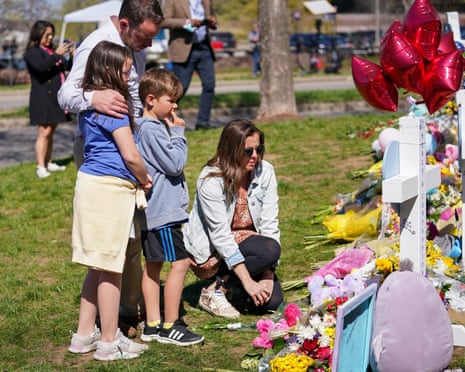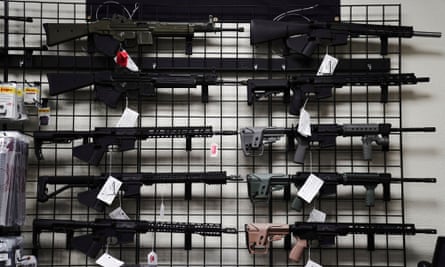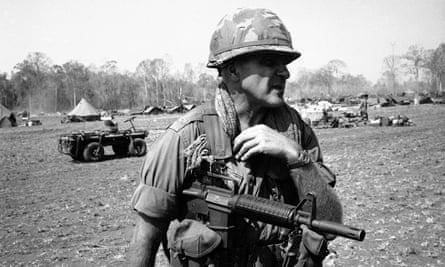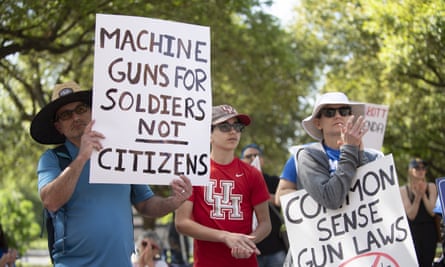
‘It’s a weapon to hunt people!’ Why so many Americans hate – and love – the AR-15
Semi-automatic rifles such as the AR-15 have become the weapon of choice for mass shooters. They’ve been banned before – yet countless gun owners are determined it will never happen again
Hogs are a big problem on Brandon Brown’s ranchland in the Texas panhandle. They tear up the ground, travel in droves and are a general nuisance, as they are in many other parts of the southern US. For some, hunting them is a combination of pastime and pest control.
So when Brown wanted to find a rifle that was accurate, lightweight and fired bullets big enough to take out a feral pig, he chose the most popular rifle in the US: the AR-15. “It’s a great hunting gun. It’s great,” Brown says. “The AR overall is pretty much indestructible.”
It is also an easy gun to use, he says – so easy that his eight-year-old son has used it to hunt deer. Brown eventually bought three of the rifles, each with a specific use and customised for target shooting or hunting at any time of day.
Brown also liked the fact that the AR-15 is semi-automatic, meaning that one squeeze of the trigger fires a single round without having to reload the rifle. Fully automatic guns, where the gun continuously fires multiple rounds as long as the trigger is pulled, have been heavily regulated in the US since the 1930s. But semi-automatic rifles such as the AR-15 have thrived to become the weapon of choice for mass shooters aiming to kill dozens of people in a very short amount of time.

In high-profile mass shootings in Colorado Springs, Uvalde, Buffalo, Midland, Dayton, Pittsburgh, Parkland, Sutherland Springs, Las Vegas, Orlando, San Bernardino, Newtown and more, bullets fired from AR-style weapons have killed again and again. Most recently, on 27 March, a shooter with two “assault type” weapons killed three children and three adults at a school in Nashville, Tennessee.
The mass shooting in Nashville has reignited a consistent and familiar debate in American life over AR-15s and other firearms. The shooting happened within hours of the Washington Post publishing an in-depth series about the gun, including detailed graphics showing what a bullet fired from an AR-15 can do to a human body – and specifically the postmortem results of two children killed in school shootings in Parkland, Florida, and Newtown, Connecticut.
President Joe Biden said last Monday that he continues to support a ban on assault weapons that has been blocked by Republicans, even as the National Rifle Association and pro-gun conservatives doubled down on claims that banning AR-15s would be an attack on the second amendment of the US constitution.
“The majority of the American people think having assault weapons is bizarre, it’s a crazy idea, so we’re against that,” Biden said last Tuesday. “I want to remind you, the last time we passed an assault weapons ban … mass shootings went down … I can’t do anything except plead with the Congress to act reasonably.” According to polls, more than 60% of Americans support the banning of semi-automatic weapons.
The crisis of gun deaths in the US is a complex quagmire of politics, cultural identity and violence that goes far beyond the horrific headlines of mass shootings. But understanding the AR-15 is key to understanding the US’s history with civilian gun ownership, says Harel Shapira, who studies US gun culture at the University of Texas at Austin. “It has become the kind of central symbol of firearms ownership,” he says.
The first time I shot with an AR-15 was at an indoor gun range in the suburbs of Dallas, Texas. I don’t own one, but I’ve shot them a few other times at ranges and private farmland. I’m always surprised by how simple they are. They’re built to be comfortable. After an easy squeeze of the trigger, the pop of the round is powerful but without the bruising recoil of other wooden or composite rifles. Each of the AR-15s I’ve shot was different, customised by its owner to express their personality. One had a foregrip at the front of the rifle for better comfort. Another had a high-end holographic sight to line up your shot. Another was wrapped in a hot pink camouflage pattern, marketed at women who like to shoot.
For gun owners, it’s the perfect hobby gun. The AR component – which stands for “ArmaLite rifle”, not “assault rifle” – is a simple mechanism that can be connected to other parts which are easy to take apart and customise. It’s why some people call it the Lego or the Barbie of guns. According to recent polling, an estimated one in 20 US adults owns an AR-15-style weapon.
Shapira compares the obsession with AR-platform customisation to American car culture. Gun owners can tinker and build the gun that fits them best. “A big part of what it means to own an AR is that you’re not just purchasing a firearm off the shelf,” he says. “It involves a process of modification, of transformation, where people come to develop really a kind of intimate relationship with ARs.”
It’s easy to buy, easy to shoot, easy to customise – all reasons why American gun owners love it. Those are also the reasons why the AR-15 is particularly deadly, and why it is popular among mass shooters.

The AR-15 has roots in the second world war, says Prof Grant Reeher, director of the Campbell Public Affairs Institute at Syracuse University in New York. While Germany and the Soviet Union developed lighter-weight semi-automatic rifles, the US military was hesitant to leave behind the tradition of heavy-calibre single-action rifles. That changed during the early days of the Vietnam war in the late 1950s, when the military adapted ArmaLite’s gas-powered semi-automatic “AR” design into what became the M-16 rifle. ArmaLite sold its design in 1959 to Colt, which began marketing a civilian version.
The AR-15’s use of plastic parts and its sleek design made it look like a “space age” weapon, in contrast to the bulky rifles of previous generations. That aesthetic popularity carried into the early 00s, during the wars in Iraq and Afghanistan, when more US civilians wanted “what the real soldiers carry”, Reeher says.
Reeher also credits the rise of first-person shooter video games like 2003’s Call of Duty with popularising the AR platform among more diverse audiences. If people liked playing the game with a virtual AR-style rifle, he suggests, then they may have been more likely to buy a real one at home.
The AR-15’s usefulness as a hunting rifle has been debated, however. Many Americans in the south use them for shooting feral pigs, as Brown does in Texas, but the .223-inch round that most AR-platform rifles fire is too small for larger game, says Reeher. “Some people have used them for deer, but not really. The hide’s too thick. That is not a limitation if you’re trying to kill a person. A person is a lot easier to kill than a deer.”
According to statistics from Everytown for Gun Safety, a political group that argues for stricter gun regulations, only 1% of American gun deaths are attributed to mass shootings. Yet in those shootings, according to the group, six times as many people are shot when an assault weapon is used. And AR-style guns were involved in 10 of the 17 deadliest shootings since 2012.
Often, perpetrators who plan their attacks seek out the AR-platform rifle for the same reasons other gun owners do, Reeher says: the aesthetics of the rifle and its military roots. There is also often a copycat element to mass shootings, which helps make the AR-15 the weapon of choice.
“It’s not a toy. It’s not a game,” says Noah Lumbantobing, a spokesperson for March for Our Lives. “It’s a weapon to hunt people.”
March for Our Lives was founded by survivors of the 2018 shooting in Marjory Stoneman Douglas high school, Parkland, Florida, where a 19-year-old gunman killed 17 and injured 17 others in about four minutes with an AR-style firearm.

March for Our Lives is one of many groups in the US pushing for a complete ban on the gun. It has been imposed before: in 1994, President Clinton signed a federal law that banned specific models (including the Colt AR-15) and general features of assault weapons – primarily the features that make up an AR-15-style rifle. Mass shooting deaths decreased during the 10 years it was enforced. A sunset provision in the law allowed the bill to expire in 2004, and it has not been renewed.
Experts who study gun violence say it’s hard to know whether the fall in overall gun homicides in the US was caused by the assault weapons ban, or was a coincidence. Yet in the decade after the ban ended, deaths from mass shootings jumped up from an average of 4.8 to 23.8 a year, according to a 2019 New York University study.
In a 2020 study, researchers at George Mason University also found that the number of mass shootings increased after the ban expired. According to the nonprofit research group Gun Violence Archive, which classifies “mass shootings” as events where four or more people are injured or killed, there have been at least 130 such killings in 2023 so far. In 2014, Gun Violence Archive counted 273 mass shootings; that figure has soared to more than 600 each year since 2020.
This is why the AR-15 platform has become as emblematic for anti-gun advocates as it is for the pro-gun lobby.
The number of deaths from gun violence overall did not experience a major drop while Clinton’s federal assault weapons ban was enforced, which is why many Republican politicians have jumped to cast the assault weapons ban as ineffective. If anything, Reeher says, Clinton’s ban has made the gun even more popular among American conservatives. According to the National Rifle Association (NRA), 25 million Americans own an AR-15-style weapon, and it is the most common rifle used for home self-defence. It’s why the NRA calls it “America’s rifle.”
“Simply because it becomes such a pariah gun, there are other gun owners that want to make sure that they’ve got at least one,” Reeher says. “There are folks that like owning them, and want to show other people that they own them, in part to make a statement about themselves politically.”
Because many places in the US permit firearms to be carried openly, AR-platform rifles have become a common sight at political protests. Along with other customisations, gun owners can buy magazines and other AR-style parts emblazoned with Donald Trump’s face, or with his “Maga” slogan.

In 2015, Texas senator Ted Cruz appeared in a video using the barrel of a semi-automatic rifle to fry bacon. South Dakota senator John Thune said last year that people in his state used the AR-15 for hunting “prairie dogs and other varmints”. Colorado representative Lauren Boebert tweeted last summer that Jesus could have used more AR-15s to “keep his government from killing him”. And earlier this year, US House representatives wore AR-15 lapel pins on the floor of Congress to show their support for gun ownership.
Guns are more than mere weapons to many Americans. They are a cultural symbol, Shapira says. “Asking the question, ‘Why do you need this?’ misunderstands a lot of why people own firearms,” he says. It’s not just about utility.
For many Americans, firing guns is a family pastime. It can be a chance for generations to bond over shared firearms that have been handed down. Taking your child shooting for the first time can be a rite of passage. According to the Washington Post’s analysis, AR-15 owners are likely to be male (81%), white (74%) and between 40 and 65 years old (56%). And for some men, the weapons are a symbol of masculinity. The custom-friendliness of the AR-15 platform allows gun owners to express their individuality, while participating in the long and violent tradition of firearms in the US.
This deeply rooted culture is part of why AR-platform rifles alone are not the only key to solving the crisis of gun violence in the US, Lumbantobing says: “If you were to somehow magically do a perfect assault weapons ban overnight, and remove every single assault weapon from America, gun violence would still occur. We’re certainly focused on banning assault weapons … But it’s just a small piece of a broader question that is this uniquely American crisis of gun violence.”
Brown says shooting his three ARs is a hobby, sure, but he also treats them as tools that are needed on his property. Still, he looks at the mass shootings and wonders how those shooters were allowed to buy their guns.
“Maybe we adjust the gun laws, but regardless of if they take them away or not, you’re still going to have stuff like that taking place,” he says. “I don’t know the answer to this, but find a way to try to make it tougher and enforce realistic gun laws for people buying.”
He thinks about when he bought his most recent AR-15. An outstanding traffic ticket in another state sent a red flag to the retailer when he tried to buy the rifle. The sale was left pending until he could clear the ticket and pay a fine. If he had to jump through those hoops for a traffic violation, he said, people intent on killing shouldn’t be able to buy those rifles.
Yet in states such as Texas, where legislators blocked red-flag laws that would help stop people with mental health concerns from buying guns, it is relatively easy to buy an AR platform rifle, as the Uvalde shooter did last May, just days after his 18th birthday. Similarly in Tennessee, in 2021 Republican governor Bill Lee, supported by the NRA, signed into law legislation allowing for permit-free open carrying of handguns (although a 2019 poll showed 75% of Tennesseans opposed such a move).
There are proposals to make it possible to carry other guns without a permit, including shotguns and AR-style rifles. Hence Republican Tennessee congressman Tim Burchett’s response to the Nashville shooting last week. “We’re not gonna fix it,” he bluntly told reporters. “Criminals are gonna be criminals … I don’t see any real role that we could do other than mess things up, honestly.” When Burchett was asked what more could be done to protect schoolkids such as his own daughter, he replied, “Well, we homeschool her.”

